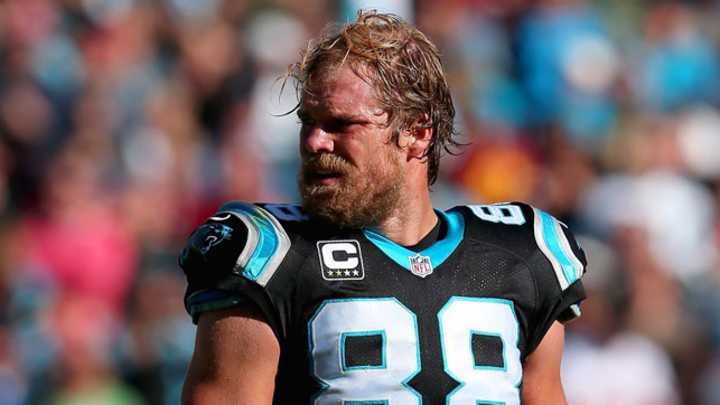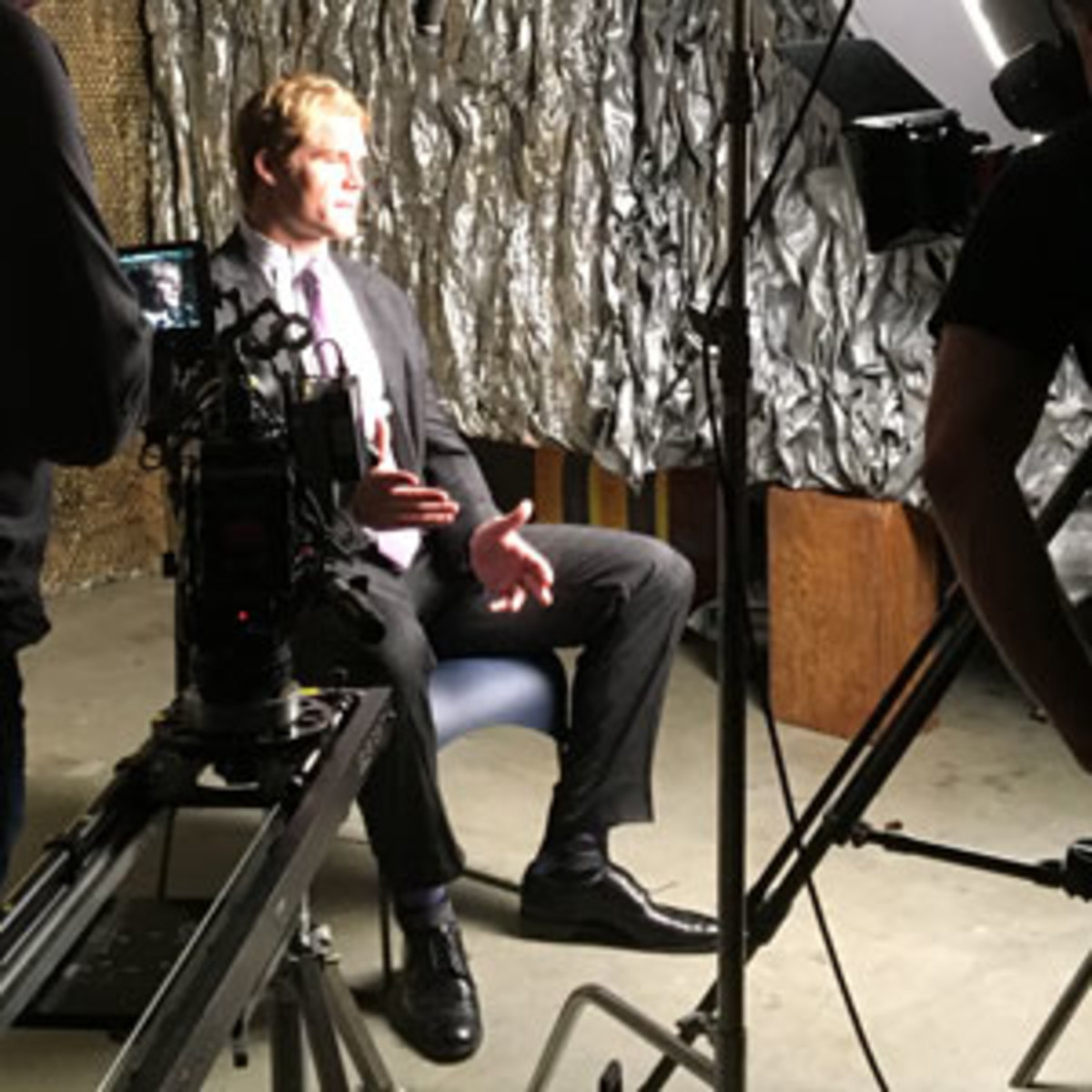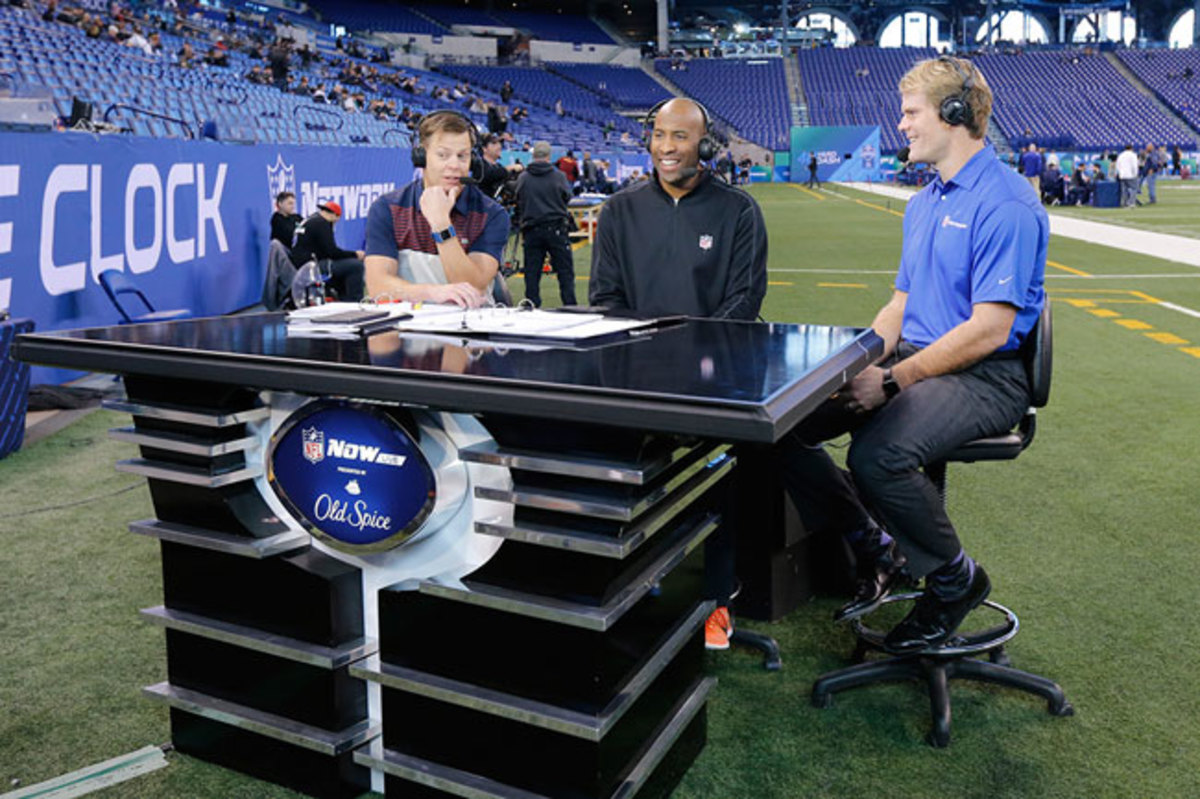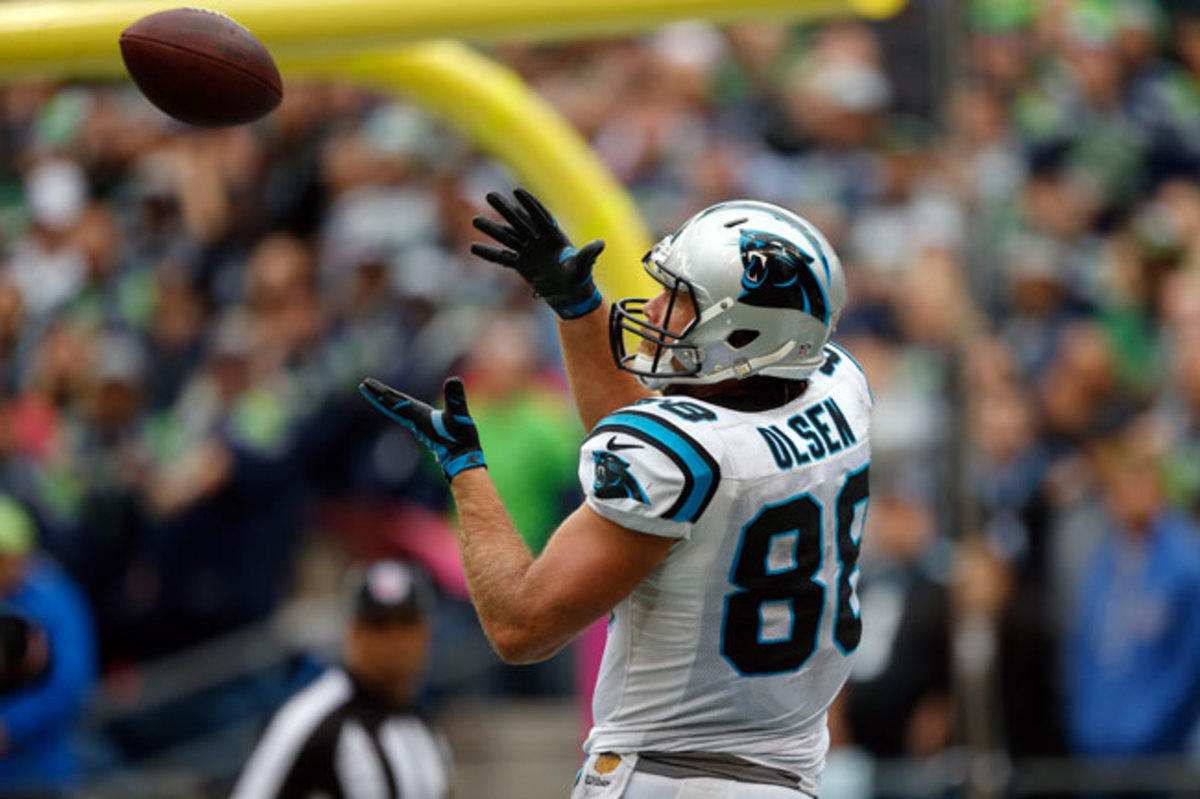Greg Olsen’s Media Makeover

INDIANAPOLIS — Three weeks after his Panthers lost in Super Bowl 50, Greg Olsen has swapped his jersey for a charcoal suit. The mountain-man beard and unkempt look he saw through the 2015 season has also been replaced by a clean shave and gelled hair. Against a backdrop of NFL prospects trying to catch a team’s eye, the All-Pro tight end walks through the bowels of Lucas Oil Stadium with a purposeful stride, intent on acing his own job interview of sorts.
Nine years after the Bears drafted him in the first round, Olsen has returned to the combine to make his debut as an NFL Network analyst. “Do you know exactly what time I’ll be on?” he says on the final Saturday in February, barely slowing down. “My dad is blowing up my phone. I think he’s kind of excited for this.”
The league’s so-called Underwear Olympics provide an annual opportunity to tryout the next crop of players, but the combine has also become a must-attend networking event for nearly 2,000 NFL personnel-types, 1,000 media members, 800 agents, countless marketing representatives and current players thinking about a career beyond the field.

Olsen flew in for two days to shake hands, exchange contact info and sharpen his on-air skills. “I’ve always been a guy who didn’t mind speaking to reporters,” says Olsen, who still has a few years left in pads and a helmet (he’ll be 33 when his contract expires after the 2018 season). “Being in the media is one of those things that so many guys say they’d like to do after they play. But you need to actually try a few different avenues to see if you like it—or if you’d be good at it.”
At noon, Olsen met with NFL Network talent producer Marcus Smith to get a rundown of the day. First, Olsen will spend an hour in a luxury suite with ESPN analyst Merril Hoge, Colts tight end Dwayne Allen and nearly two dozen fans as part of a meet-and-greet. Then, if he’s amenable, an interview for an upcoming special on his former teammate, Matt Forte. “Oh I’d love to,” Olsen says. “He’s one of my best friends.” After that, Olsen will go to the field to report during tight end drills and then do a live segment with NFL Network anchors Bucky Brooks and Matt Smith.
“Do you guys want me to wear this suit on the field?” he asks.
“Actually, we have a polo for you to wear,” Smith says. “Figured you’d be more comfortable.”
“Now that is the best news I’ve heard all day.”

* * *
The night before, Greg Olsen dined with Merril Hoge at the Capitol Grille and then sat courtside as the Pacers hosted the Hornets, trying to soak up as much as possible from his mentor. A 10th-round pick of the Steelers in 1987, Hoge’s football career was derailed by injury after his seventh season. In 1996, the running back joined the crew at ESPN. His second career, the 51-year-old Hoge says, “began with Chuck Noll.”
The Steelers’ Hall of Fame coach famously lectured players about finding their “life’s work” beyond football, repeating a variation of the same speech three times a year: once during training camp (before some would soon be cut), during the season (usually after a tough loss) and as the team cleared out their lockers. “Don’t waste your offseason,” Noll would say. “Use it to explore what you want to do with your life, so you have a life’s purpose.”
Hoge heeded that advice and took a job selling insurance one summer. He reported to a nondescript office park, settled into his cramped cubicle and soon determined “this is not for me.”
A year later, the Pittsburgh radio station B-94 asked Hoge to call in during the season and do interviews. At the time, he was the first active player to have a regular radio spot. Hoge enjoyed the freedom to explain certain plays in depth and educate fans on how the offense really unfolded. The following year, Hoge was approached by DVE, a competing station that offered him $15,000 a year to be on air.
There had to be a catch, Hoge figured, and there was: He had to be at the station every Monday at 7 a.m. “But once I walked into the studio, that was it,” Hoge says. “I loved the energy, I loved everything about it. Just like Coach Noll said, I saw an opportunity, and I took advantage.”
When Hoge signed with Chicago in free agency in 1994, he kept the spot on DVE—and has kept his call-in spot to this day.
“That’s fantastic,” Olsen says. “I love that.”
Olsen isn’t sure if he wants to be a traditional analyst like Hoge, opine like Stephen A. Smith or host a show like Dan Patrick. Two seasons ago, Olsen debated Smith on ESPN’s First Take and defended Cam Newton. Smith argued that Newton’s putting a towel over his head represented defeatism. Olsen countered that Newton puts a towel over his head after interceptions, punts and touchdowns. “That’s his thing,” said Olsen, who thought of himself as a lawyer in that scenario. He had to make his case, support it with evidence, and be more persuasive than his opponent.
“I just love information,” says Olsen, a self-described news-junkie who patrols Twitter for stories on topics as varied as football and entrepreneurship. To prepare for his NFL Network spot, Olsen memorized statistics and characteristics of the tight end prospects. It wasn’t taxing work; he follows college football and has a strong foundation of knowledge. When Hoge mentions that his son, Beau, is a quarterback at BYU, Olsen rattles off the names of the last four Cougars QBs without any hesitation. Olsen is most concerned about avoiding clichés while on TV. “That’s a guy with upside, that’s a guy who needs to keep his head on straight,” Olsen says. “If you catch me saying either of those sayings…”
* * *

Olsen has a favorite story about his own combine experience in 2007. The New Jersey native interviewed with the Jets, and head coach Eric Mangini introduced him to nearly 30 team employees in the room. When Olsen finally sat down, Mangini pointed to a man in the corner.
“What’s that guy’s name?” the coach asked.
“Uh,” Olsen stammered. “I don’t know, sir.”
“And that guy?”
“I don’t know, sir.”
Olsen ended up correctly identifying just one person.
“And that’s because I knew his son,” Olsen says. “That interview was the perfect illustration of what the combine is. It’s about creating stressful situations and then stripping it all away to figure out if a guy is mentally capable of performing at the next level— and then if he’s physically capable.”
At the meet and greet on Saturday, Olsen works the room like a seasoned pro. Memphis quarterback Paxton Lynch can be seen landing his 36-inch vertical leap on six televisions in the room, but Olsen is completely focused on the fans. He becomes animated when answering a question about Cam Newton, throwing his arm over Dwayne Allen’s shoulder: “How much do you weigh?”
“Uh,” Allen chuckles. “It is the offseason… but 265.”
“And I’m 255,” Olsen tells the group. “So imagine Cam’s body as right in the middle of us. He’s 260, runs a 4.5 and can do things no other quarterback can do. Now, you can find quarterbacks who can win in other ways. But teams need to stop looking for another Cam, because really, there is nobody else like him out there.”
After signing a few autographs, Olsen is off to film the interview about Matt Forte. But first, a pit stop. Olsen pokes his head into the suite where Panthers coach Ron Rivera is evaluating prospects. “Hey, find us some players, why don’t you!” he says.
Olsen is then escorted into a storage room that has been turned into a makeshift studio. Even though he wasn’t given much time to prepare, Olsen answers every question about Forte with personal detail and fluidity. “I remember when I first time I saw him at a workout,” Olsen says, “And my first impression: that’s a quiet, humble guy.” The word “um” is absent from Olsen’s vocabulary. “If only every interview was this easy,” a cameraman says as Olsen exits six minutes later.
“You just can’t overcomplicate things,” Olsen says. “Just speak to the viewer like you're speaking regularly.”
An hour later, Olsen is sitting on the field, telling Brooks and Smith about why a prospect might be nervous for combine drills: “You’re not used to the routes that they ask you to run, they’re laying out cones, which is not realistic.”
A half hour after that, Olsen is back in his suit, sitting amongst four other NFL Network analysts and offering a candid assessment of the 2016 group. “The routes I thought, for the most part, were OK,” he says. “You saw a lot of guys sometimes struggling to track the balls in the over the shoulders … I would have liked to see [Arkansas tight end] Hunter Henry run. He came in as the clear cut No. 1 guy in the group. We’ll have to wait for his Pro Day.”
The experience, Olsen says, wasn’t drastically different than speaking to a scrum of reporters after a game.
“It was immediately evident he was taking this seriously and was prepared,” says Mike Muriano, the senior coordinating producer. “He was natural, comfortable and was himself, and I think that showed. In my opinion, he absolutely has a future in this if he wants to do it.”
“I enjoyed it,” Olsen says, with a qualifier: “I’m not ready to stop playing quite yet.”
Question? Comment? Let us know at talkback@themmqb.com
